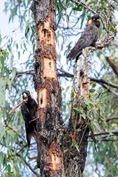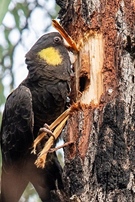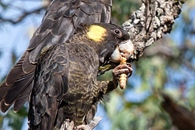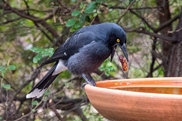In February 2020 I was at Distillery Creek Picnic Area and heard Yellow-tailed Black Cockatoos in the trees.
High up, were perched a male and a young one, while nearby a female methodically tore bark from a rather distressed ironbark tree.

I watched her for nearly an hour as she ripped large pieces of bark away in a pattern of rectangles rotating up the tree.

Yellow-tailed Black Cockatoos feed on larvae, in this case, of the Longicorn Beetle. The adult beetles live under the bark or on the trunk, and the grubs tunnel into the wood. These beetles don’t kill healthy trees, but invade vulnerable specimens.
The cockatoos test the tree for fully grown larvae by pecking at frass (excrement) exit holes. They tap the tree near the exit holes and listen for a solid sound to indicate the grub is present. If it sounds hollow, they move on. This cockatoo bit along the top and bottom of the rectangle then ripped the bark off. It’s amazing what neat patches she tore away and how she knows not to ringbark the tree.
She flew to a nearby branch and ate the large larva like an ice cream.

She didn’t offer it to the male or juvenile, and they didn’t make any effort to take it from her. She ate at least two in the hour I was watching. You can see a little more information about ‘Predation of Cossid Moth Larvae by Yellow-Tailed Black Cockatoos’ in the synopsis of this publication
https://www.publish.csiro.au/wr/wr9780101. Although the article speaks about different moths and larvae, the general information about Yellow-tailed Black Cockatoos’ larvae foraging is of interest.
More recently in my garden during the lockdown I observed a Grey Currawong regurgitating pellets of undigested food into the bird bath.

You may have noticed red pellets around the base of your birdbath, or spreading out in the water. Over time the colour fades and the seeds remain. Currawongs are notorious for spreading weeds such as Boneseed and Ivy.
Thanks to John Lenagan for additional information about moths and larvae.
Margaret Lacey